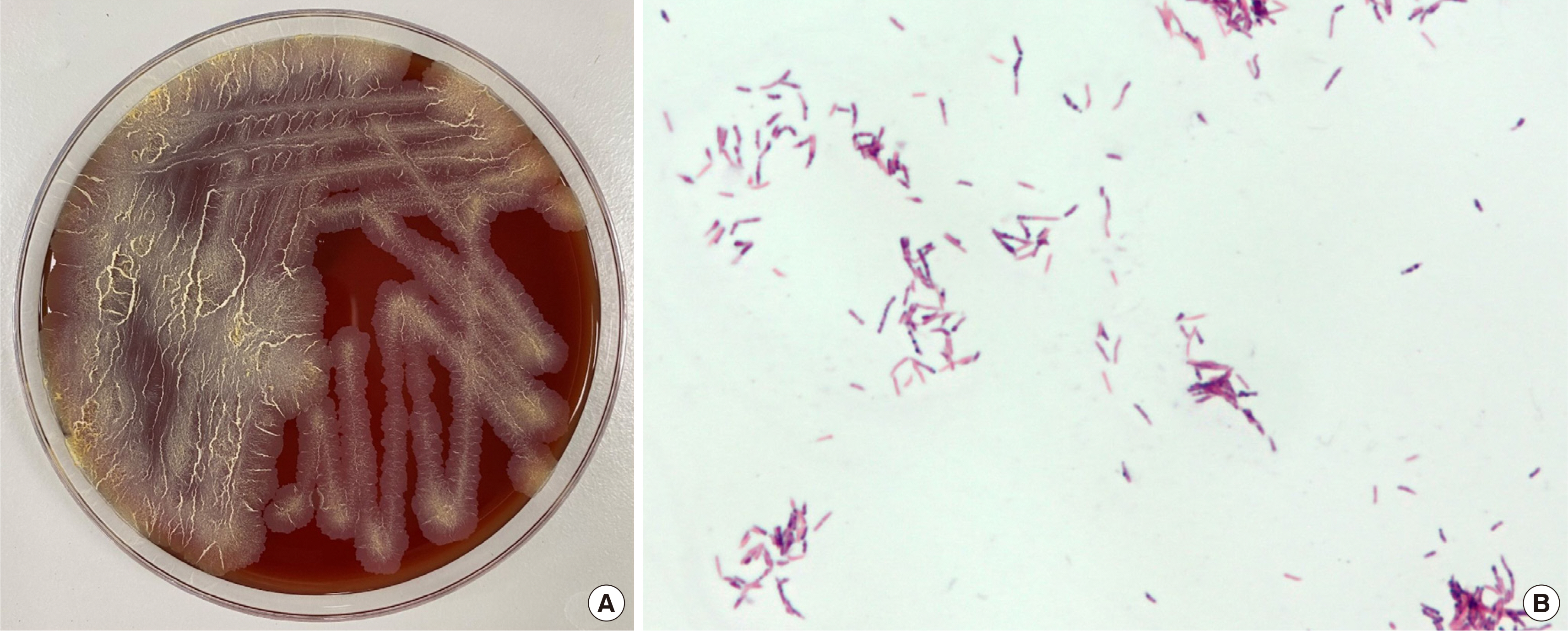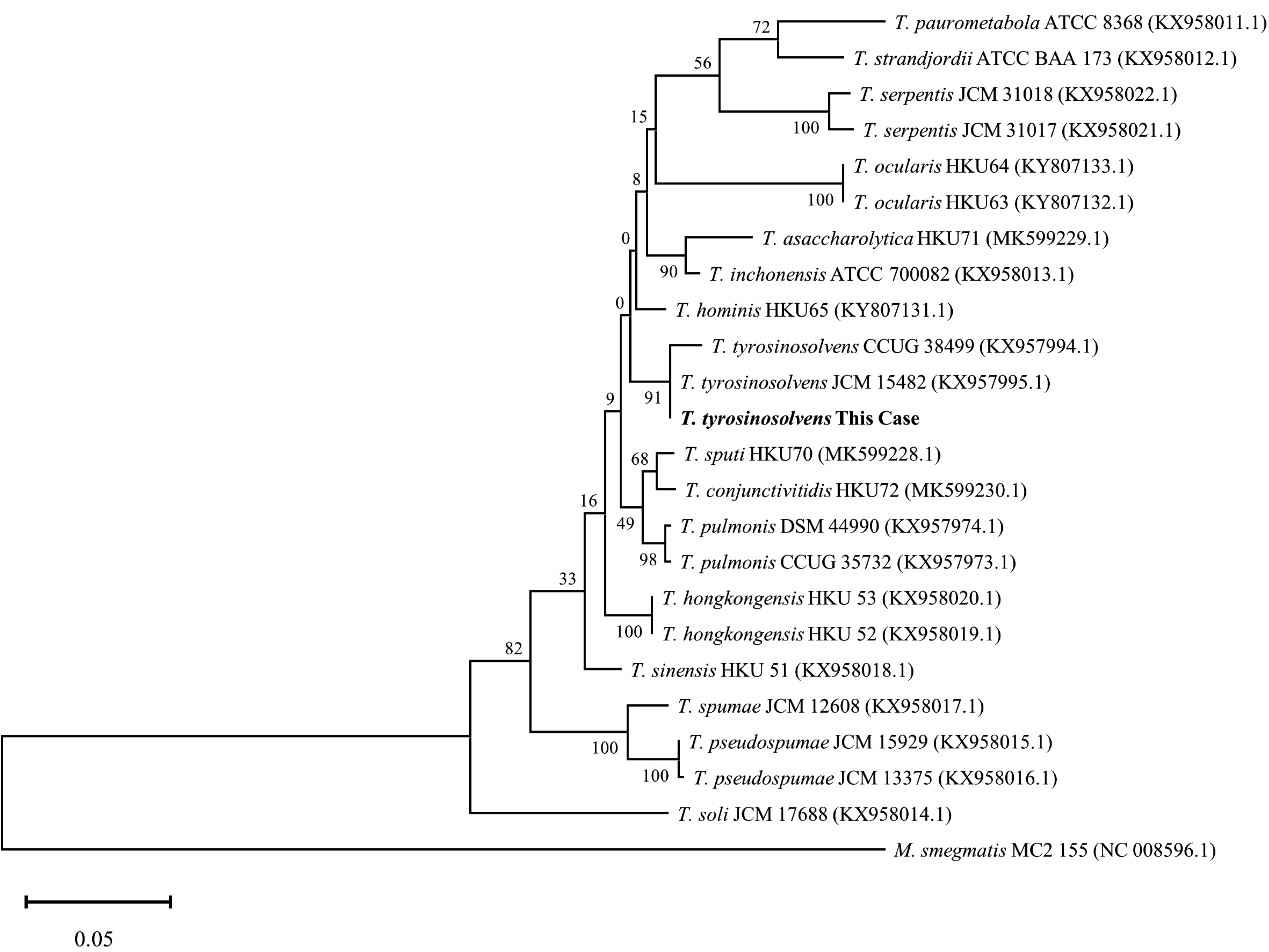Lab Med Online.
2022 Jan;12(1):68-73. 10.47429/lmo.2022.12.1.68.
A Case of Catheter-Related Bloodstream Infection Caused by Tsukamurella tyrosinosolvens
- Affiliations
-
- 1Department of Laboratory Medicine, Seoul National University Hospital, Seoul, Korea
- 2Department of Laboratory Medicine, Seoul National University College of Medicine, Seoul, Korea
- 3Department of Laboratory Medicine, Seoul National University Boramae Medical Center, Seoul, Korea
- KMID: 2538587
- DOI: http://doi.org/10.47429/lmo.2022.12.1.68
Abstract
- The genus Tsukamurella is an aerobic actinomycete found in soil, and rarely infects humans. Herein, we report a case of catheter-related bloodstream infection caused by T. tyrosinosolvens. An 8-year-old girl with a central line for home parenteral nutrition was admitted via the emergency room due to fever. Gram-positive bacilli were detected in two aerobic blood culture bottles among the three pairs of blood cultures. The isolate was not identified by VITEK 2 (bioMérieux, USA) but was identified as Tsukamurella spp. by matrix-assisted laser desorption ionization time-of-flight mass spectrometry using the microflex LT (Bruker Daltonics, Germany). The 16S rRNA sequences of these bacteria indicated over 99.73% identity match with T. tyrosinosolvens, T. hominis, and T. ocularis. The groEL gene was sequenced because of low interspecies 16S rRNA sequence variability in the genus Tsukamurella. The isolate showed 99.51% identity with T. tyrosinosolvens. The patient was treated with antibiotics, including vancomycin and piperacillin/tazobactam. T. tyrosinosolvens was detected in one aerobic blood culture bottle among the three pairs of blood cultures on the second day of hospital stay. Three sequential follow-up blood cultures were negative for the microorganisms. To our knowledge, this is the first report of catheter-related bloodstream infection caused by T. tyrosinosolvens in Korea. This study demonstrated the usefulness of groEL gene sequencing for accurate identification of Tsukamurella spp.
Figure
Reference
-
1. Safaei S, Fatahi-Bafghi M, Pouresmaeil O. 2017; Role of Tsukamurella species in human infections: first literature review. New Microbes New Infect. 22:6–12. DOI: 10.1016/j.nmni.2017.10.002. PMID: 29556401. PMCID: PMC5857166.2. Nam SW, Kim W, Chun J, Goodfellow M. 2004; Tsukamurella pseudospumae sp. nov., a novel actinomycete isolated from activated sludge foam. Int J Syst Evol Microbiol. 54:1209–12. DOI: 10.1099/ijs.0.02939-0. PMID: 15280293.3. Seo Y, Chung HS, Lee Y, Kim J, Yong D, Jeong SH, et al. 2012; A case of catheter-related bloodstream infection by Tsukamurella inchonensis in a pediatric patient receiving home intravenous antibiotic treatment. Lab Med Online. 2:105–10. DOI: 10.3343/lmo.2012.2.2.105.4. Chong Y, Lee K, Chon CY, Kim MJ, Kwon OH, Lee HJ. 1997; Tsukamurella inchonensis bacteremia in a patient who ingested Hydrochloric acid. Clin Infect Dis. 24:1267–8. DOI: 10.1093/clinids/24.6.1267. PMID: 9195101.5. Leroy AG, Persyn E, Guillouzouic A, Ruffier d'Epenoux L, Launay E, Takoudju EM, et al. 2020; Catheter-related bloodstream infection due to Tsukamurella pulmonis identified by MALDI-TOF spectrometry, 16S rRNA gene sequencing, and secA1 gene sequencing in an immunocompromised child: a case report and literature review. Diagn Microbiol Infect Dis. 97:115052. DOI: 10.1016/j.diagmicrobio.2020.115052. PMID: 32312485.6. Clinical, Laboratory Standards Institute. 2018. Interpretive criteria for identication of bacteria and fungi by targeted DNA sequencing. Wayne, PA: CLSI guideline MM18. 2nd ed. Clinical and Laboratory Standards Institute.7. Teng JLL, Fong JYH, Fok KMN, Lee HH, Chiu TH, Tang Y, et al. 2020; Tsukamurella asaccharolytica sp. nov., Tsukamurella conjunctivitidis sp. nov. and Tsukamurella sputi sp. nov., isolated from patients with bacteraemia, conjunctivitis and respiratory infection in Hong Kong. Int J Syst Evol Microbiol. 70:995–1006. DOI: 10.1099/ijsem.0.003861. PMID: 31738158.8. Clinical, Laboratory Standards Institute. 2018. Performance standards for susceptibility testing of mycobacteria, Nocardia spp., and other aerobic actinomycetes. 1st ed. CLSI document M62. Wayne, PA: Clinical and Laboratory Standards Institute.9. Teng JLL, Tang Y, Wong SSY, Chiu TH, Zhao Z, Chan E, et al. 2018; Tsukamurella ocularis sp. nov. and Tsukamurella hominis sp. nov., isolated from patients with conjunctivitis in Hong Kong. Int J Syst Evol Microbiol. 68:810–8. DOI: 10.1099/ijsem.0.002589. PMID: 29458478.10. Teng JLL, Tang Y, Wong SSY, Fong JYH, Zhao Z, Wong CP, et al. 2018; MALDI-TOF MS for identification of Tsukamurella species: Tsukamurella tyrosinosolvens as the predominant species associated with ocular infections. Emerg Microbes Infect. 7:80. DOI: 10.1038/s41426-018-0083-4. PMID: 29739926. PMCID: PMC5940693.11. Ménard A, Degrange S, Peuchant O, Nguyen TD, Dromer C, Maugein J. 2009; Tsukamurella tyrosinosolvens-An unusual case report of bacteremic pneumonia after lung transplantation. Ann Clin Microbiol Antimicrob. 8:30. DOI: 10.1186/1476-0711-8-30. PMID: 19909497. PMCID: PMC2780973.
Article12. Park JC, Hong J, Soe JG, Chung WK, Seo YH, Lee HH. 2009; A case of Tsukamurella tyrosinosolvens peritonitis associated with continuous ambulatory peritoneal dialysis. Korean J Med. 76:225–8.13. Bond A, Chadwick P, Smith TR, Nightingale JMD, Lal S. 2020; Diagnosis and management of catheter-related bloodstream infections in patients on home parenteral nutrition. Frontline Gastroenterol. 11:48–54. DOI: 10.1136/flgastro-2018-101094. PMID: 31885840. PMCID: PMC6914297.
Article14. Ross VM, Guenter P, Corrigan ML, Kovacevich D, Winkler MF, Resnick HE, et al. 2016; Central venous catheter infections in home parenteral nutrition patients: Outcomes from Sustain: American Society for Parenteral and Enteral Nutrition's National Patient Registry for Nutrition Care. Am J Infect Control. 44:1462–8. DOI: 10.1016/j.ajic.2016.06.028. PMID: 27908433.
Article15. Rupp ME, Karnatak R. 2018; Intravascular catheter-related bloodstream infections. Infect Dis Clin North Am. 32:765–87. DOI: 10.1016/j.idc.2018.06.002. PMID: 30241718. PMCID: PMC8322176.
Article16. Liu CY, Lai CC, Lee MR, Lee YC, Huang YT, Liao CH, et al. 2011; Clinical characteristics of infections caused by Tsukamurella spp. and antimicrobial susceptibilities of the isolates. Int J Antimicrob Agents. 38:534–7. DOI: 10.1016/j.ijantimicag.2011.07.018. PMID: 22014886.17. Kattar MM, Cookson BT, Carlson LD, Stiglich SK, Schwartz MA, Nguyen TT, et al. 2001; Tsukamurella strandjordae sp. nov., a proposed new species causing sepsis. J Clin Microbiol. 39:1467–76. DOI: 10.1128/JCM.39.4.1467-1476.2001. PMID: 11283073. PMCID: PMC87956.18. Teng JLL, Tang Y, Huang Y, Guo FB, Wei W, Chen JHK, et al. 2016; Phylogenomic analyses and reclassification of species within the genus Tsukamurella: insights to species definition in the post-genomic era. Frontiers in Microbiology. 7:1137. DOI: 10.3389/fmicb.2016.01137. PMID: 27493643. PMCID: PMC4955295.
Article19. Teng JLL, Tang Y, Chiu TH, Cheung CL, Ngan AH, Ngai C, et al. 2017; The groEL gene is a promising target for species-level identification of Tsukamurella. J Clin Microbiol. 55:649–53. DOI: 10.1128/JCM.02260-16. PMID: 27974536. PMCID: PMC5277538.20. Vancuren SJ, Hill JE. 2019; Update on cpnDB: a reference database of chaperonin sequences. Database (Oxford). 2019:baz033. DOI: 10.1093/database/baz033. PMID: 30820575. PMCID: PMC6395794.
Article
- Full Text Links
- Actions
-
Cited
- CITED
-
- Close
- Share
- Similar articles
-
- A case of Tsukamurella tyrosinosolvens peritonitis associated with continuous ambulatory peritoneal dialysis
- A Case of Catheter-Related Bloodstream Infection by Tsukamurella inchonensis in a Pediatric Patient Receiving Home Intravenous Antibiotic Treatment
- Central Venous Catheter Colonization and Bloodstream Infection: Influence of Catheter Insertion Site and Duration
- A Case Report of Tsukamurella pulmonis Infection Misidentified as Atypical Mycobacteria
- Diagnosis and Management of Central Venous Catheter-Related Infections



